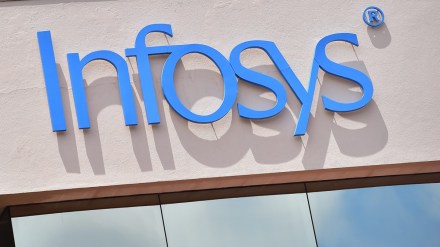The April–June quarter for the IT majors was broadly subdued. Among the big Four – Tata Consultancy Services (TCS), Infosys, HCLTech, and Wipro – Infosys stood out as the only company to report revenue growth in constant currency, while its peers registered declines both sequentially and in margins.
As acknowledged by Infosys CEO and MD, Salil Parekh, the broader economic backdrop remains anything but stable. Parekh said that while discussions around global macroeconomic trends appear more settled than before, they are still far from resolved. The industry continues to be in flux amid geopolitical tensions, reduced discretionary spending, and evolving client priorities.
Infosys outperforms
Infosys emerged as the relative outperformer in this environment, reporting a sequential revenue growth of 3.3% and revising its constant currency revenue growth forecast for FY26 to 1-3%, up from the earlier 0-3%. The company appears to be benefitting from the steady execution of large short-term deals signed earlier in the year. With its fourth straight quarter of headcount growth and a stable margin profile, Infosys is showing signs of resilience that some of its peers lacked this quarter.
Competitors performance
In contrast, Tata Consultancy Services, the largest of the four, posted its first revenue decline in over four years. The impact was especially pronounced in the domestic market, where revenues plunged 32.6% quarter-on-quarter due to the winding down of a major project with BSNL. While TCS did manage to post a 4.4% growth in net profit, aided by one-off income tax interest gains and reduced costs, the underlying numbers point to tepid client activity and ongoing caution in the business environment. Its performance in international markets, especially Europe, also weakened, aligning with the overall commentary about continued softness in the consumer and manufacturing verticals.
HCLTech’s quarter was marred by a sharp drop in profit and operating margins, with the latter falling by 160 basis points to 16.3%, the steepest among the four firms. The company attributed this to low employee utilisation, continued investments in AI capabilities, and a one-time client bankruptcy. Despite nearly flat revenue growth, its headcount declined, suggesting delayed ramp-ups of existing deals and an evolving demand environment that is yet to stabilise.
Wipro, meanwhile, delivered a mixed performance. Although it posted a 1.6% drop in revenue, it managed to beat analyst expectations and signaled a degree of optimism by citing robust deal wins worth nearly $5 billion. This suggests that Wipro, like Infosys, could be better positioned in the second half of the fiscal year, provided those deals translate into tangible topline growth. However, its headcount shrank for the quarter, reflecting the cautious stance that companies are adopting amid uncertain demand trends.
Across the board, North America, the primary market for these IT giants, offered little growth, while Europe remained a mixed bag. The continued caution in client spending, especially for discretionary and transformation projects, highlights the lingering impact of global geopolitical events and trade frictions. Still, all four firms are banking on AI-driven transformation and efficiency programmes to drive future growth, even as they recalibrate hiring and utilisation strategies to match the uncertain demand environment.
